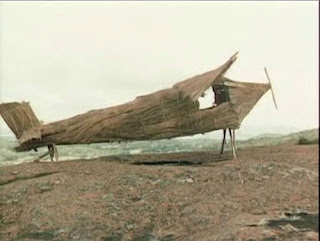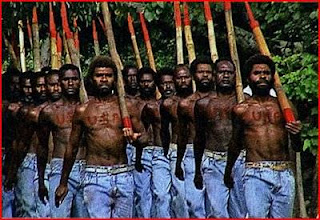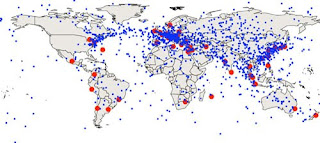One of the key perspectives in the work of Adam Possamai in regard to the ‘hyper-real’ postmodern pop-culture belief systems comes from his background as a sociologist. As a result of this, he frames a lot of his analysis of the phenomenon as manifestations of late-capitalism. Put simply, he sees them on one level as product.
He’s got a point. Pop culture, by definition, is something we can buy. (Or steal, or bootleg… but I’ll get to that later.) It’s a manifestation of mass production and dissemination. It’s worship of things you can buy in a shop. Production line totems.
In other words, it’s kind of like a cargo cult.
The last remaining cargo cult, the worship of a semi-mythical (possibly black US Army soldier) John Frum is on the South Sea island of Tanna. It’s well worth reading Mike Jay’s 2002 piece on the history and current state of the Vanatu who worship Frum. Jay finds the history of Frum-worship rife with meaning and symbolism for our times. Frum is a mercurial figure – a Jesus/Moses/Spartacus figure, who has inspired automatically-received songs in languages the Vanatu do not speak. One of my favourite stories of the Frum-inspired rebellion against colonial rule, told by Jay, goes:
…by 1941 there was no doubt that something was going on. A ‘prophet’ named Manehevi from Sulphur Bay had been arrested and tied to a tree for a day by the colonial administration, pour encourager les autres, but John Frum continued to appear. Subsequent witnesses had been deported and imprisoned. Then, big news: a huge detachment of American troops had arrived on the neighbouring island of Santo. Not only had these Americans brought unheard-of amounts of cargo – arms, tanks, boats, food, medicine – but a considerable number of them were black. The centuries of unbroken symmetry between foreigners (white, rich) and locals (black, poor) had been broken, and the black GIs were variously interpreted as descendants of the islanders who’d been kidnapped by plantation owners in the past, or as John Frum’s own detachment of the US army. Messianic fervour gripped Sulphur Bay, and one Sunday morning the new movement came out into the open with a baffling act of civil disobedience which sent shock-waves through the white community. The compulsory attendance at the Presbyterian church was universally ignored; instead, a group of locals walked solemnly into the white-owned trading post and carefully removed every price label from the stock.
That last touch, the peaceful occupation of a symbol of the privileged of capitalism struck me as awfully similar to the approach taken at the weekend by the UKUncut affinity group, who protested the draconian public service cuts in Britain by a peaceful sit-in at one of London’s poshest shops, Fortnum and Mason.
All 150-odd non-violent activists caused no more damage than knocking over a chocolate Easter bunny (symbolic sacrifice?)… and were tricked out of the building by police – told they were being moved for their protection, then nicked as soon as they were out.
A couple of days after that action, I first read the Mike Jay piece… and today I read this: Islands at the Speed of Light, at BLDGBLOG:
A recent paper published in the Physical Review has some astonishing suggestions for the geographic future of financial markets. Its authors, Alexander Wissner-Grossl and Cameron Freer, discuss the spatial implications of speed-of-light trading. Trades now occur so rapidly, they explain, and in such fantastic quantity, that the speed of light itself presents limits to the efficiency of global computerized trading networks.These limits are described as “light propagation delays.”[Image: Global map of “optimal intermediate locations between trading centers,” based on the earth’s geometry and the speed of light, by Alexander Wissner-Grossl and Cameron Freer].It is thus in traders’ direct financial interest, they suggest, to install themselves at specific points on the earth’s surface—a kind of light-speed financial acupuncture—in order to take advantage both of the planet’s geometry and of the networks along which trades are ordered and filled. They conclude that “the construction of relativistic statistical arbitrage trading nodes across the Earth’s surface” is thus economically justified, if not required.Amazingly, though, their analysis—seen in the map, above—suggests that many of these financially strategic points are actually out in the middle of nowhere: hundreds of miles offshore in the Indian Ocean, for instance, on the shores of Antarctica, and scattered throughout the South Pacific (though, of course, most of Europe, Japan, and the U.S. Bos-Wash corridor also make the cut).These nodes exist in what the authors refer to as “the past light cones” of distant trading centers—thus the paper’s multiple references to relativity. Astonishingly, this thus seems to elide financial trading networks with the laws of physics, implying the eventual emergence of what we might call quantum financial products. Quantum derivatives! (This also seems to push us ever closer to the artificially intelligent financial instruments described in Charles Stross’s novel Accelerando).It’s financial science fiction: when the dollar value of a given product depends on its position in a planet’s light-cone.
Wouldn’t it be interesting if one of those financial feng-shui nodes just happened to be on or near Tanna? If the actual control of the world’s cargo were to flow through Frum’s land? There’s also the distinct possibility of quasi-national libertarian states, like the late lamented Sealand, could pop up too.
John Frum versus John Galt?
The control, both financially and possibly magically, of the products of late capitalism, caught in our local light cone, distributed at lightspeed. The swiftest of the messengers of the gods of cargo.
One of these products of late capitalism, a comic book produced by the Time-Warner/DC empire (specifically Neil Gaiman’s Sandman), once suggested that all human religions are cargo cults. It’s a throwaway idea, what Gaiman himself called a ‘notion’ rather than a fully-fledged idea. But it’s one that stuck with me, because the language of commerce and trade has infiltrated everything. We talk metaphorically of the cost of our actions, the price we have to pay, the deals we must strike. The death toll of a military action, in British military slang, is called the Butcher’s Bill. And England, let us not forget, was described by Napoleon as a nation of shopkeepers. And if England are shopkeepers, what then are Americans?
One of the biggest ever US pop-culture influences world-wide is undoubtedly Star Trek. And it’s really interesting to me that the show makes a point of saying that a precondition of their relatively utopian and egalitarian society is that “we outgrew the need for money”… without actually telling us how they did so. Further, when Star Trek’s later iterations appeared, this was underlined further by the appearance of a culture which far more closely resembles the character of modern capitalist society than the enlightened Federation.. the Ferengi.

(It’s notable and ironic that the name Ferengi derives from the Arabic/Persian word for foreigner…)
(Remember that awful buddy flick Swingers? It strived to make the phrase “you’re so money” into a synonym for coolness. It was made in 1996, at the tailing edge of the cultural worship of flash cash that brought us Wall Street and Loadsamoney. And it wouldn’t surprise me to see it being remade in this new resurgence of that current. For fucksake, they remade that most egregious of capitalist wank fantasies, Arthur…)
Possamai, I must note, is scrupulously fair about the way capitalism influences faith. He notes how there’s an opposite reaction to the hyper-real religions – a kind of hypo-real fundamentalist pushback, limiting the faithful’s access to a ‘free market’ of ideas, offering narrow but plentiful products of their own. It’s perfectly possible for a child to be, for example, raised, educated and employed entirely within a climate of, say, Xtian Dominionism – they have their own books, toys, TV shows, internet realms, pop music, comics – all the things the hyper-real draws on but neutered, made acceptable within their paradigm. And it’s almost too obvious to note how their megachurches increasingly resemble corporations, their temples more and more like malls.
And the Chaotes, the Newagers of every stripe, the Na’Vi and the Jedi and the FSMites… all work their ways, buy the albums and books and DVDs and action figures and How To Speak Klingon CDs and on and on… many of them deeply suspicious of just how that cargo ends up in their hands. As suspicious as the Vanatu, with no John Frum to lead them.
So, knowing all this… how’s a denizen of the capitalist, English-speaking West to react to this? How do we find our spiritual, mythic and magical place within these mass-produced possibilities?
I’ll take a look at that next time.


